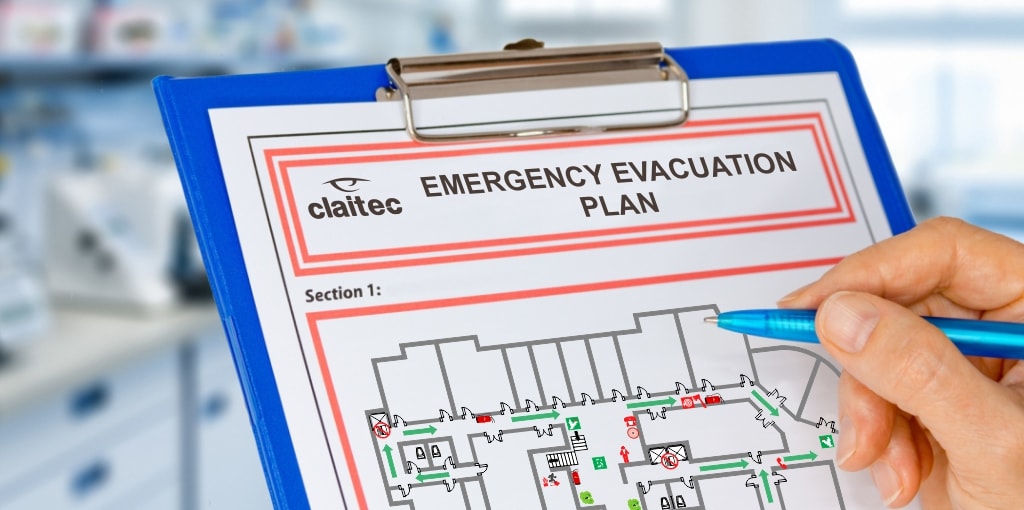Keeping your company safe means protecting the people that make it what it is. When it comes to responding to an emergency, those people and your company are put at risk. The best way to keep everyone safe is to take the time and create an emergency evacuation plan. But in order to have an effective evacuation plan, your company needs to keep some important things in mind.
Setting Expectations
The key to creating and maintaining an effective emergency plan begins with knowing exactly what you want. It is important to know the necessary timeframe for a successful evacuation, and where employees are expected to go during the emergency. The ‘where’ and ‘evacuation time’ are the most important expectations to get in order. These must be based on the risks of your company in particular. You cannot properly institute risk prevention policies without being aware of the potential risks you face.
In the event of a serious emergency, there may be areas of the building that are more likely to be compromised than others: rooms containing highly flammable substances, areas with obstructions, etc. This means that these parts of the building should be avoided during an evacuation. In the case of the storage of combustible or other potentially harmful materials, an evacuation point should be a safe distance away from these areas.
How long you have to evacuate will mainly be dependent on the types of risks your company faces. Always plan for the timeframe of the emergency that has the shortest time allotted for evacuation. That way you can evacuate fast enough to protect your employees no matter what happens.
Alternative Evacuation
We all know the saying about best-laid plans, and how they often go awry. An emergency evacuation plan should take this into account most of all. As much as you can try to expect the unexpected, there are always complications. People can panic and create unanticipated problems for even the best plans. Similarly, safety measures you planned to rely on could fail in the moment. That is why a truly effective evacuation strategy is somewhat fluid. A comprehensive workplace safety model will take all these factors into account, in order to craft a seamless emergency evacuation strategy.
There should never be one available exit path or one relied upon rendezvous point. These are just not reliable enough to stake the well-being of all your employees on. The confusion that can ensue during an emergency is often due to excessively rigid evacuation plans. That rigidity can make all the preparation worthless. That is why training and planning must be dynamic. In these extreme and unpredictable situations being able to account for employees is a must. At the end of the day, it is about making sure everyone is safe.
Practice
An emergency plan is not complete without a plan of how to teach it and train people to use it. And far too often practice breeds complacency. Employees and even employers begin to simply go through the motions of drills and training. I believe that all forms of practice must be somewhat confrontational in order to be effective. This is not to say that these drills and planning sessions should be disrespectful, but they should challenge employees. The expectations that you have set should be maintained, and there should be experimentation with alternative evacuations.
One of the best methods of practice is to simply ask employees about the evacuation plan. When they propose a way of exiting the building, have a probable means of denying it. They say, “I would use the emergency exit at the end of the hall.” You respond, “The roof over that exit has caved in. What do you do?” This shakes people out of complacency. They are no longer being led or relying solely on what they already know.
This kind of confrontational preparation gets the mind working in the ways needed to solve problems during the high stress of an emergency. Also, businesses can incentivize their employees to encourage more participation in the safety program. Furthermore, rigorous practice helps highlight workplace risks that come in handy during a workplace risk assessment.
The Safety Mindset
There is a cost to safety. It takes both an investment of time and money to create the most effective plans. You will need to set aside time to train employees on safety procedures and the proper way evacuate. And training, drills, and other forms of practice must be ongoing to assure the effectiveness of the overall safety strategy. The company will also need to have effective safety and security technology.
As mentioned above, tracking your employees is invaluable for evacuation planning. Not only will you be able to know that everyone made it out, in the worst case scenario you will be able to point emergency responders in the right direction. It is also important to have the physical safety and security devices in the building working effectively.
Doors and locks are especially important, as malfunctions of this type can lead to lockouts, trapping employees during an emergency. Sticking doors, locks that are not turning smoothly, etc., should be seen as red flags.
Most of the time security professionals can salvage this type of security hardware with maintenance, but you must always be willing to invest in installing new commercial locks. There are a good selection of warehouse locks that can be used to bolster your warehouse security and keep your emergency evacuation plan well rounded. Whenever something is not working, you cannot shy away from the cost of safety.
Final Thoughts
To have an effective emergency plan, you need to know what you are looking to accomplish. Where people are evacuating to, and how fast they need to get there. There must be room for things to change without causing a catastrophic breakdown in the plan. This comes from dynamic and confrontational practice methods. And at the end of the day, the willingness to invest the resources into this preparedness will determine how safe your employees and company are.

